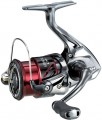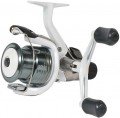Number of bearings
The number of bearings provided in the design of the reel. Bearings are used to reduce friction of rotating parts, which, on the one hand, protects such parts from wear, and on the other hand, reduces excessive effort expended when the handle is rotated. Accordingly, the
more bearings, the more friction units are protected and the better the coil is “optimized”; this parameter is a good indicator of the overall class of the product. At the same time, it is necessary to evaluate different models taking into account their purpose (see "Type").
So, in fly fishing reels, even quite expensive ones, 1 bearing is usually provided — at the point of installation of the drum on a bracket designed for attachment to the rod. This is actually the only significant friction point, so more bearings are simply not required. For multiplier reels, this number varies from 1 for relatively simple options to 6 – 7 for premium ones. And in inertia-free bearings, the number of bearings can reach a couple of dozen.
Drag
The clutch type describes the location of the friction brake mechanism provided in the reel and, accordingly, its adjustment knob.
The friction brake itself is responsible for loosening the reel at a critical force: when the load increases significantly, a properly adjusted friction clutch pits part of the fishing line, preventing it from breaking. But the specific actuation force may differ: some fishermen prefer to loosen the brake as much as possible, allowing the line to slip with rather weak jerks, while others, on the contrary, tighten it, allowing operation only when dangerously approaching the breaking load. And in some situations, you need to change the settings right in the process of playing. The convenience of such a reconfiguration is one of the points that is affected by the type of clutch. In addition, design features may be due to the purpose of the coil. Specific options might be:
—
Front. Friction located directly in the drum, with an adjustment knob on the front of the reel. It is used in inertialess models (see "Type"). It is slightly lighter and simpler in design than the
rear one, making it well suited for light tackle (for example, when fishing in a match). But the adjustment of such a brake, on the one hand, is smoother and more accurate than that of the rear one, on the other hand, it is not so convenient when setting it up on the fly and requires a certain skill.
...In addition, the front clutch is more sensitive to dirt.
— Rear. Another option for placing the clutch in inertialess models. Its name is due to the fact that the drag is located behind the spool, and the adjustment knob is on the back of the reel. Such coils allow you to easily reconfigure the brake right during the fight, and their balance is somewhat more convenient than that of the “front-wheel drive”, because. the design does not have a characteristic "overweight" forward. On the other hand, the adjustment in this case is less accurate, and the coils themselves are somewhat larger and heavier, which makes them poorly suitable for ultralight gear.
— Side. A similar placement of the clutch is typical for multiplier coils — it makes no sense to use other options in such models, as well as to put a side clutch in an inertialess model.Gear ratio
The gear ratio describes the difference in the speed of rotation of the spool and the handle. In reel specifications, it is often written as a ratio of the form x:1, where one indicates 1 turn of the handle, and “x” is the number of turns of the spool in one such turn. To simplify the record, only the first number is indicated in our catalog — for example, the designation 5.2 corresponds to a gear ratio of 5.2: 1.
First of all, the ratio between the speed and the "torque" of the coil depends on this parameter. So, high gear ratios allow you to quickly pull the line, which is important for high-speed wiring — but the power of such reels will be low, and significant efforts on the handle will be required to pull large prey. Conversely, at low numbers, the speed of the line will be small, but you will not have to make significant efforts to move it. In models of the inertialess type (see above), gear ratios of the order of 6 – 7 denote the so-called "high-speed" coils, 4 – 4.5 – "power", and intermediate values \u200b\u200bare universal. Due to their specificity, multiplier models usually have low gear ratios, and the high power of fly fishing reels is due to the fact that the angler rotates the drum directly in them, and the gear ratio is 1.
Spool capacity
The amount of line that can fit on the main spool of a reel with normal winding. It is indicated as a ratio of two numbers, the first of which corresponds to the length of the reeled line in metres, and the second to the thickness in millimetres: for example, the numbers 200 / 0.45 indicate that up to 200 m of fishing line with a thickness of 0.45 mm can fit on the reel.
For different types of fishing, there are recommendations on the optimal value of this parameter; they can be found in special sources. Here we note that the capacity of the spool is indicated exclusively for a smooth fishing line; when using a braided cord, the actual performance may differ markedly.
Spare spool material
The material of the
spare spool(drum) supplied with the reel.
Additional interchangeable spools are provided to expand the capabilities of the reel: if necessary, you can quickly replace the fishing line with tackle of a different thickness (or the same one instead of a broken one), install a reduced drum to increase the casting distance, etc. As for the materials for such spools (
plastic,
aluminium,
graphite), they do not differ from those used in the main drums; see the relevant paragraph above for more details.
Weight
The total weight of the reel (only the device itself, without fishing line). This parameter is important, first of all, for those who select equipment of
the ultralight class — in such gear, the struggle is, as they say, for every extra gram. In other cases, you can not pay special attention to weight.

